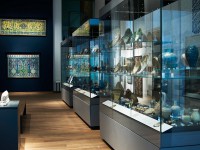Room 31 | Islamic Middle East gallery
Explore artefacts made over a period of more than 1000 years in the heart of the Islamic world.

Geometrical patterns are used throughout the art and architecture of the Islamic lands. They range from the simple division of a surface into triangles or squares to very intricate repeating designs that use combinations of curved and straight lines. These patterns are very flexible and can be applied to many different surfaces.
Although Islamic scholars had a sophisticated knowledge of mathematics and geometry derived from the Greeks, decorative designs were not usually created by mathematicians. Skilled craftsmen built patterns of great complexity using simple geometrical rules.
Notice
Objects may have since been removed or replaced from a gallery. Click into an individual object record to confirm whether or not an object is currently on display. Our object location data is usually updated on a monthly basis, so contact the Jameel Study Centre if you are planning to visit the museum to see a particular Eastern Art object.
© 2013 University of Oxford - Ashmolean Museum






